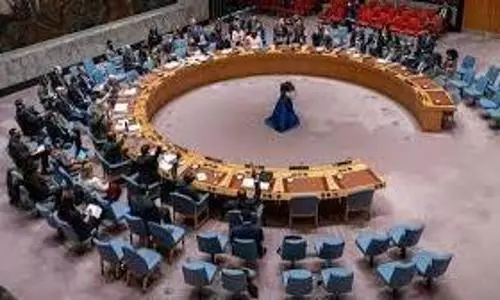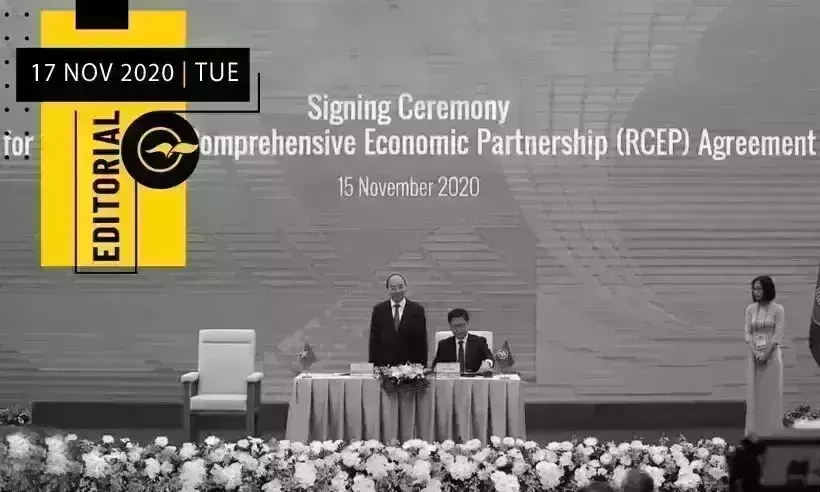
India and RCEP pact
text_fieldsAfter eight years of arduous negotiations, the Regional Comprehensive Economic Partnership (RCEP) agreement has become reality. The world's largest trade pact was signed at the ASEAN annual conference in Hanoi, Vietnam. An inference will not be off the mark that henceforth the large bloc consisting of ASEAN countries, Indonesia, Thailand, Singapore, Malaysia, Philippines, Vietnam, Brunei, Cambodia, Myanmar and Laos, together with China, Japan, South Korea, Australia and New Zealand, will control global trade. For, these 15 countries dominate or are involved in, a third of the world's trade transactions, plus holding 30 percent of the world's GDP. A significant point to note is that when the seeds of the concept of such a pact were sown at the last ASEAN summit in Cambodia in 2012, India was at its forefront and had taken active part in the negotiations but subsequently withdrew from it. Central government sources explain that the withdrawal was prompted by the assessment that the heavy domination of China, with a clear upper hand in the group, would be to India's disadvantage. It has also been observed that beyond this explanation, the government's decision has political and diplomatic dimensions as well. Regardless of that, withdrawal from RCEP will undoubtedly bring no small relief to the farmers, medium industries and entrepreneurs of the country – reason enough to welcome the government's decision from that perspective.
As early as in November last year, at the ASEAN summit held in Bangkok prime minister Narendra Modi had proclaimed that India was withdrawing from the pact, citing the reason that the terms of the agreement were not fair and balanced enough to be beneficial to all parties. However, India announced its withdrawal after attempting until the last round - and failing - to win acceptance for some special protective provisions, as a condition to signing it. And it was at that stage that China, Australia and other countries made a public statement that regardless of the absence of India, they would proceed with the pact. In fact, in principle the Modi government had no objections to RCEP. And hence Modi's activie participation and readiness for discussions and bargaining at the ASEAN forum. Already, government agencies including NITI Ayog had warned about several provisions in the draft that would clearly be detrimental to the country's economic sector. Even then, over two dozen rounds of ministerial level negotiations were held for making a fremework for the pact. In the meantime, Modi was moving forward with it, despite stiff protests by the opposition, farmer organisations and even outfits affiliated to the ruling alliance. States such as Kerala passed resolutions against the pact. It was ignoring this range of opposition that Modi arrived at the ASEAN venue. In this background, although at least come quarters had expected a change of mind in India's position, the government decided not to yield before China's hegemony.
Had the government taken a different decision, it would have turned into another tragic picture like that with ASEAN. If India had the pact, which targets 'free trade' by reducing tariffs to the lowest, the country's agrarian and industrial sectors would have been brought to a grave crisis. The agricultural products from China alone, the sixth largest exporter of crops in the world, would be enough to decimate India's agricultural market. Further, with the entry of Australia and New Zealand - the world's leading dairy exporting countries - India's dairy producers also would be pushed to poverty. Viewed thus, withdrawing from RCEP has saved India from a pact that has the potential to most enterprises, big and small, ranging from cottage industries to hi-tech Artificial Intelligence. However, this protection is can also turn out to be short-lived. For at any time, India can join the pact, for which calls have already started coming - both from within and outside.
There is still an apprehension that the Modi government may make a rethinking, if there are some ways to shore up corporates from the possible traps within the pact. At the same, on another level, the pressure from America and European Union is also troubling the Centre. Since there are pacts with these countries, including in the defence sector, India may have constraints in entering a pact that would harm their monopoly in such sectors. Apart from all this, a section of observers also view the current Indian decision as a political move against China, given that all is not well in the country's ties with it. At any rate, for an economy that had to take a severe beating from measures of 'economic reforms' including the note-ban and an unscientifically implemented lockdown for Covid prevention, the current decision will definitely come as welcome relief.























